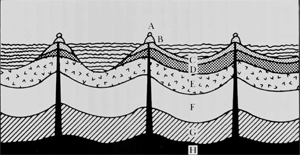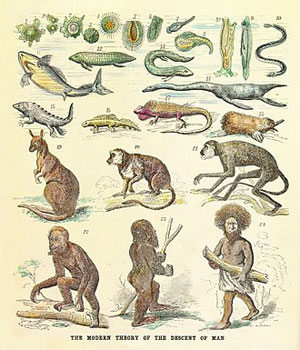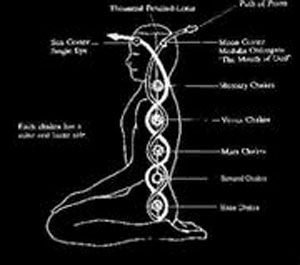Gregory Bateson’s Theory of Mind: Practical Applications to Pedagogy
by Lawrence S. Bale
November 1992
copyright© 2000 by Down 'n Out Press All rights reserved
NOTICE: THIS WORK MAY BE PROTECTED BY COPYRIGHT
YOU ARE REQUIRED TO READ THE COPYRIGHT NOTICE AT THIS LINK BEFORE YOU READ THE FOLLOWING WORK, THAT IS AVAILABLE SOLELY FOR PRIVATE STUDY, SCHOLARSHIP OR RESEARCH PURSUANT TO 17 U.S.C. SECTION 107 AND 108. IN THE EVENT THAT THE LIBRARY DETERMINES THAT UNLAWFUL COPYING OF THIS WORK HAS OCCURRED, THE LIBRARY HAS THE RIGHT TO BLOCK THE I.P. ADDRESS AT WHICH THE UNLAWFUL COPYING APPEARED TO HAVE OCCURRED. THANK YOU FOR RESPECTING THE RIGHTS OF COPYRIGHT OWNERS.
This is how Jung describes the relationship of the individual to the collective unconscious according to this diagram:I have often been asked about the "Geology" of a personality, and so I have tried to picture this after a fashion. Diagram 10 shows individuals coming out of a certain common level, like the summits of mountains coming out of a sea. The first connection between certain individuals is that of the family, then comes the clan which unites a number of families, then the nation which unites a still bigger group. After that we could take a large number of connected nations such as would be included under the heading "European man." Going further down, we would come to what we call the monkey group, or that of the primate ancestors, and after that would come the animal layer in general, and finally the central fire, with which, as the diagram shows, we are still in connection. [91]
A = Individuals.
B = Families.
C = Clans.
D = Nations.
E = Large Group (European man, for example).
F = Primate Ancestors.
G = Animal Ancestors in general.
H = "Central Fire."
Figure 1. Jung's diagram of the geology of the human personality (from Analytical Psychology, p. 133).
-- The Jung Cult: Origins of a Charismatic Movement, by Richard Noll
Gregory Bateson was one of the first scholars to appreciate that the patterns of organization and relational symmetry evident in all living systems are indicative of mind. We should not forget that due to the nineteenth century polemic between science and religion, any consideration of purpose and plan, e.g., mental process, had been a priori excluded from science as non-empirical, or immeasurable. Any reference to mind as an explanatory or causal principle had been banned from biology. Even in the social and behavioral sciences, references to mind remained suspect. Building on the work of Norbert Wiener and Warren McCulloch,1 Bateson realized that it is precisely mental process or mind which must be investigated. Thus, he formulated the cybernetic epistemology and the criteria of mind that are pivotal elements in his “ecological philosophy.” In fact, he referred to cybernetics as an epistemology: e.g., the model, itself, is a means of knowing what sort of world this is, and also the limitations that exist concerning our ability to know something (or perhaps nothing) of such matters. As his work progressed, Bateson proposed that we consider Epistemology as an overarching discipline of the natural sciences, including the social and behavioral sciences: a meta-science whose parameters extend to include the science of mind in the widest sense of the word.
Ideally, teaching should entail an unending search for theoretical and methodological perspectives that inspire and challenge teacher and students alike. In that spirit, this essay presents an overview of the cybernetic principles that influenced so much of Bateson’s work, and discusses his understanding of the concepts information and communication, which are pivotal elements of his “cybernetic epistemology” and his theory of mind. The essay concludes with a brief rendering of Bateson’s “learning theory,” and since the essay reflects the highly abstract and formal tone of Bateson’s work, at various junctures along the way some of the practical applications that this complex material may have for pedagogy are indicated.
The Cybernetic Paradigm: A Brief Introduction
The term Cybernetics was coined by Norbert Wiener, at the end of World War Two, in reference to the, “entire field of control and communication theory, whether in the machine or in the animal.”2 As such, cybernetics has become a master concept which assimilated a number of analytic methods, including computerization and simulation, set theory, graph theory, net theory, automata theory, decision theory, queueing theory, game theory, and general systems theory. As is apparent in the wealth of available literature, cybernetic processes became discernible to many theorists, not only in biological systems, but also in the sub-organic and supra-organic world—from microphysics to organic life, through social groups, to the biosphere of our planet, and beyond.
The introduction of cybernetic principles led to the identification of systemic invariance or isomorphisms throughout the observable cosmos. Here we should note that whether or not employment of the cybernetic paradigm has been appropriate in each instance remains an area of dispute. Nevertheless, once perceived, the recognition of such patterns has fostered a valuable epistemic shift: from consideration of discrete “entities,” to the discernment of whole systems. The recognition of systemic patterns also initiated further disclosure of the logic evident in the behavior and interaction of systems, enabling theorists to frame the formal characteristics inherent in whole (e.g., cybernetic) systems. The properties of such a system are identified as fourfold:
1. The system is a holistic and cannot be reduced to its parts without altering its pattern. Artificially composed aggregates, wherein the constituent elements can be added or subtracted without altering the overall system are not included.
2. The system is self-regulating, stabilizing itself through negative feedback loops. Thus, cybernetic systems respond to information. They scan their behavior to determine its outcome, and if this “input” or feedback communicates a match with the system’s “coded requirements,” the system maintains its output, its behavior, in order to maintain the match (i.e., it maintains a steady-state). If the system “learns” that its coded requirements are not being matched, it modifies its behavior on the basis of such information.
3. The system is self-organizing. If a mismatch between sensory input and “internal code” persists, the system searches for, and encodes a new pattern with which to operate. Thus, in the passage of time, differentiation and complexification of the overall system may emerge through positive feedback.
4. Moreover, the system is understood as a differentiated sub-whole within a systemic hierarchy. The “environment” in which a system exists is also a whole system, a meta-system. Whether ecosystem, animal, organ or cell, systems consist of subsystems that operate within a hierarchy of progressively inclusive meta-systems. As a subsystem, the system’s characteristics and operations are co-determinative components of the larger system within which it is an integral component. Thus, a system may be understood as Janus-faced. As a whole, it faces inward, i.e., the system is concerned with maintaining its internal steady state; as a sub-whole, the system faces outward, responding to its environment (a meta-system) in a potentially infinite regression of relevant contexts.
Spurred by the enthusiasm with which cybernetics was received, systems research has been applied to many fields of scientific enquiry. Such research supports the evolutionary view that over time, through self-organization and mutual adaptation, systems tend to form structural hierarchies, i.e., they fashion progressively larger, more inclusive systems out of preexisting sub-systems. Furthermore, in the patterns they exhibit, these new systems generate unique qualities, including more complex organization and inherently novel forms of operation.
The view which has subsequently emerged discerns a complementary relationship between the morphic nature of systemic integration and systemic differentiation within a hierarchical universe. Systemic differentiation and integration are conventionally understood as delimited by the channeling of energy, matter and information to maintain and generate form.3 Also, through the cybernetic interaction of their patterns of operation, systems tend to complexify and form hierarchies. Hence, in the realm of astronomy, hierarchical restraints are understood as gravitational; in the hierarchy from microphysics to organic life, cybernetic restraints are understood as electrochemical forces; and in social and cognitive hierarchies, such constraints are understood as operating in the communication of symbols.4
Notably, such research has also revealed that this phenomenon is delimited by hierarchical restraints of a morphic nature.5 That is, in each of these realms the hierarchical constraints are related to pattern formation, not substance or quantity. Each step between the hierarchies advances the development of form toward increasingly complex organization. Also, systems proponents point out that in asserting the irreducibility of levels, the hierarchical view of cybernetic/systems theory conflicts with traditional monism, as well as with dualism and pluralism.6 That is, since hierarchical constraints produce both novelty and organization, causal or generative relations necessarily exist between the levels.
Hence, the cybernetic/systems view of observed reality is hierarchical: the universe is understood as a hierarchy of systems, wherein each higher level of system is composed of systems of lower levels. In this view, each level of the hierarchy cybernetically builds on more basic levels of organization: integrating pre-existing subsystems and micro-hierarchies into novel patterns; and fashioning new, more inclusive systems. Therefore, as observed in embryology, evolution and child development, growth and learning occur incrementally or step-wise. Whole systems never begin from scratch. Their growth is inevitably based upon the organization of pre-organized components. They are both delimited and enabled by hierarchical constraints that permit stability, economy, and speed in the unfolding of new forms of life and more inclusive hierarchical levels.
Since their introduction, investigation of the holistic, self-stabilizing, self-organizing and hierarchical traits formally identified in cybernetic systems has also spread into the social and behavioral sciences. Thus, the informational nature of cybernetic processes: including the concepts of feedback, mutual causality, and self-regulating systems—i.e., that cybernetic systems adapt to and alter their environments through sequences of self-stabilization around steady states—have been adopted and fruitfully employed in these disciplines.
Arguably, the most significant contribution of cybernetics to these disciplines stems from an appreciation of the informational character of the processes evident in cybernetic systems. Along with other vital insights, this view supports a collapse of the supposed dichotomies between “subjective” and “objective” data. Consequently, through the employment of the cybernetic paradigm, phenomena previously dismissed as non-empirical—including feeling, emotions, cognition and perception of meaning—were judged accessible and relevant to scientific inquiry. In summary, we may note that the principles underlying the cybernetic paradigm have been recognized as a valuable means of conceptualizing humankind, not only as a biological entity, but also as a social and cognitive being.7
Some scholars have objected to the “dehumanizing” effect of applying principles derived from machines to the study of human beings. Yet, the aim of employing cybernetic theories in the social and behavioral sciences has never been to reduce identity formation—e.g. subjective learning processes, unconscious symbolic processes, etc.—to the principles of system organization. What is claimed, is that cybernetics provides a legitimate analogy, although not an exact one, “which explains a much wider variety of outcomes in terms of the significance of information,” than has previously been available.8 As such, cybernetic principles also hold valuable insights for the field of pedagogy.
For instance, we may assume that a classroom of students (including the instructor) rapidly becomes a holistic system comprised of self-stabilizing, self-organizing personalities, each of whom perceives the class through their own set of past experiences, and each of whom is concerned with maintaining an internal, or personal, balance of predefined expectations and goals. Hence, any “new information” that enters the holistic, and mutually causal system of the class will be uniquely perceived and responded to by each personality within the class. Each personality within the class will receive-organize-translate information according to their own set of self-stabilizing patterns— patterns that have succeeded, over time, in allowing the “individual” to “fit” within the context of a learning environment. From this perspective teaching is a dialogical process in which the teacher’s primary role is one of establishing or communicating contexts wherein the students may effectively perceive and assimilate “new information.”
Since every person in the classroom is a holistic, self-stabilizing, self-organizing system, but also a participant in a larger more inclusive system—e.g., the learning environment or class, which also operates as a holistic, self-stabilizing, self-organizing system—a crucial component of the dialogical teaching process must include a recognition and enhancement of the “feedback circuitry” that enables the larger context of the class to operate as holistic system. As a holistic unit, the class develops it own history of interaction, and as anyone who has led a class will note, no one part of the system can effectively exercise unilateral control over the entire system. In short, the class co-evolves, and every member of the class develops their own strategies for appropriately responding to the messages of interrelationship(s) that govern a class’ becoming. In this intricate and complex process, an effective teacher must be skilled at dialogical and trans-contextual communication: i.e., communicating contexts wherein diverse systems (personalities) can effectively exchange information; recognizing and effectively responding to various manifestations of negative, positive and regenerative feedback; and, assisting students in the largely unconscious processes of learning to learn.
Envisaging the Negentropic Realm of Mind: A Realm of Communication, Information, and Learning
Our consideration of Bateson’s model of mind, his cybernetic epistemology, and his theory of learning, necessarily begins with his criteria of mind. The criteria listed below are intended to differentiate the phenomena of thought from the much simpler phenomena observed in material events. Hence, the six criteria of mental process are intended to provide a list, “such that if any aggregate of phenomena, any system, satisfies all the criteria listed, I shall unhesitatingly say that the aggregate is a mind and shall expect that, if I am to understand that aggregate, I shall need sorts of explanation different from those which would suffice to explain the characteristics of its smaller parts.”9
Criteria of Mind 10
1) A mind is an aggregate of interacting parts or components.
2) The interaction between parts of mind is triggered by difference, and difference is a nonsubstantial phenomenon not located in space or time; difference is related to negentropy and entropy rather than energy.
3) Mental process requires collateral energy.
4) Mental process requires circular (or more complex) chains of determination.
5) In mental process, the effects of difference are to be regarded as transforms (i.e., coded versions) of events which proceeded them. The rules of such transformation must be comparatively stable (i.e., more stable than the content), but are in themselves subject to transformation.
6) The description and classification of these processes of transformation disclose a hierarchy of logical types immanent in the phenomena.
Bateson argues that using the above criteria the mind-body dilemma is soluble. He also asserts that, “the phenomena which we call thought, evolution, ecology, life, learning, and the like occur only in systems that satisfy these criteria.”11
From the above discussion of the cybernetic paradigm, the degree to which the informational nature of cybernetic process has informed Bateson’s criteria is readily apparent. One might insist that he has reduced mental process to the operations of cybernetic systems. However, he consistently maintained that the criteria are intended to be employed as an analogous and metaphoric model of mind. Above all, the criteria are intended for use as a tool of abduction, e.g., comparing that which is shared among apparently unrelated phenomena.
In part, the aim in this essay is to consider how the model of mind, or mental process that emerges from Bateson’s criteria of mind relate to the phenomena of learning. After all, it is “mind” that learns. Therefore, we should examine each of the criteria before moving on to discuss the practical applications of Bateson’s theory of learning.
1) A mind is an aggregate of interacting parts or components. The model of mind mapped out by Bateson’s criteria is holistic, and as with all serious holism it is premised on an interaction of differentiated (as opposed to separate or individual) ‘parts.’12 Holistic systems require a differentiation of parts, or there can be no differentiation of events and functioning. Therefore, mind is understood as an aggregate of differentiated parts, which at their primary level are not themselves mental. These ‘parts’ in combined interaction constitute wholes, or whole mind systems. In more complex instances, some of the ‘parts’ of a mind system may fulfill all the necessary requirements of the criteria. In this case, these ‘parts’ are also recognized as minds, or subminds. In either case, mind or mental process is understood as immanent in, and emergent from “certain sorts of organization of parts.”13
With this foundation for understanding mental process, we may now consider the nature of the relationships within which mind is immanent, or out of which mind emerges, i.e., how the relationships between the ‘parts’ interact to create mental process.
2) The interaction between parts of mind is triggered by difference, and difference is related to negentropy and entropy rather then energy. Here, the informational nature of cybernetic process is first incorporated into the criteria, and we encounter a clarification of the concept “information,” as distinct from “energy” and “matter.” We are also introduced to the limitations of knowing in this model of mind.
Beginning with an idea as the basic unit of mental process, Bateson defines an idea as, “A difference or distinction or news of differences,” adding that more commonly we refer to complex aggregates of such units as ideas.14 Of course difference is a nonsubstantial phenomenon that cannot be located in space or time. The difference between an egg and an apple does not lie in the egg or in the apple, nor does it exist in the space between them.
In agreement with Kant, Bateson notes that even the simplest of objects “contain” an infinite number of differences, but only differences which make a difference are used in forming mental images—ideas, or aggregates of ideas. Mind responds only to the differences in its environment that it is able to discern. And in this process, the holistically bonded ‘parts’ that comprise mind systems act as a sort of filter or sieve, sorting, selecting and collecting and subsequently decoding information, i.e., differences, or news of difference.15 Ideas (news of difference, images, maps) about things is what get into the working circuitry of mind, but mental systems know nothing of “things-in-themselves” (Dinge an sich).16 In short, mind systems are influenced by maps, never territory.
This suggests why Bateson feels cybernetic models and metaphors are most appropriately applied to the realm of mental process, i.e., mind systems. Given the importance of information and communication in cybernetic theory, and the unique status of information (news of difference) as a nonsubstantial phenomenon that nevertheless influences, governs and controls a cybernetic system, it ought to be evident that cybernetic models best exemplify mental process. Thus, the use of energy and matter as explanatory principles is clearly inappropriate—except in those instances where they function as information and thus have communicational value.
Consider the fact that in the realm of communication and information, zero has a “causal” value because it represents a difference, it is different from one, and zero (quite literally, no ‘thing’) may thus be used to explain a response in both the realms of communication and mental process. In this context, quantifiable concepts such as power, gravity, and energy, etc. are applicable only in the so-called “hard sciences”—i.e., realms of explanation used in exploring the physical realm of material events. In contrast to cybernetic systems (including our computers), atoms, molecules and stones do not respond to information. There is no evidence that these entities scan their behavior for its result, nor do they modify future behavior on the basis of such information.
Thus, in contrast to Laszlo and others, Bateson feels we should reject the application of cybernetic feedback principles in describing and explaining atomic, subatomic and electrochemical realms of physical existence. He also believes that given the preponderance of metaphors and explanatory principles borrowed from the energetics and hard sciences, we must totally re-think most of the theoretical basis underpinning much of the social and behavioral sciences.
3) Mental process requires collateral energy. Although the interactions of mental process are triggered by difference, “difference is not energy and usually contains no energy.”17 Mental process requires some amount of energy (apparently very little), but as a stimulus the nonsubstantial phenomenon of difference does not provide energy. The respondent mind system has collateral energy, usually provided by metabolism. If we kick a stone, it receives energy and it moves with that energy. However, if we kick a cat or a dog, our kick may transfer enough energy to move the animal, and we may even imagine placing the animal into a Newtonian orbit, but living organisms generally respond to stimuli with energy from their own metabolism. In the control of animation by information, energy is already present in the respondent, the energy is available in advance of the “impact” of events.
4) Mental process requires circular (or more complex) chains of determination. Since the central themes of this holistic model are drawn from the recursive nature of cybernetic systems, there is a fundamental emphasis on circular causal chains in mental process. Here again, mind is understood as immanent in the combined interaction of the differentiated ‘parts’ of the system, and this interaction depends upon the existence of a network of circular, or more complex, chains of determination, i.e., the parts of the system are connected and interact within a closed circuit. Since the system is circular (i.e., recursive), effects of events at any point in the circuit will move around or throughout the system, eventually producing changes at the point of origin. Thus, “a special sort of holism is generated by feedback and recursiveness,” in the system.18
Moreover, in accordance with the regularities discovered in cybernetic systems, the closed circuitry—in combination with the effects of time—generates a holistic matrix in which no one part of the system can exercise unilateral control over the system as a whole. Each part is controlled by information moving throughout the closed circuitry of the whole system. Such systems are subject to the effects of time, and therefore, each part must adapt to the time characteristics of the system. Thus, each part must adapt to the effects of its own past action within the system.19 Hence, the mental properties of the system are understood as immanent, not in any one part, but within the system as a whole. For example, mental process (e.g., mind) is understood as immanent in the circuits of the brain which are complete within the brain; mental processes are similarly immanent in the circuits which are complete within the system, brain-plus-body; and mind is immanent in the larger system — person-plus-environment.20 The resulting image requires that we eliminate the commonly held notion that mind is to be identified as residing only within the boundary of our physical body, and is somehow radically separate from others:
. . . there is no requirement of a clear boundary, like a surrounding envelope of skin or membrane, and you can recognize that this definition [of mind] includes only some of the characteristics of what we call “life.” As a result it applies to a much wider range of those complex phenomena called “systems,” including systems consisting of multiple organisms or systems in which some of the parts are living and some are not, or even to systems in which there are no living parts.21
The resulting image also suggests that authoritative methods of teaching are not going to be as effective as apprenticeship methods of instruction. Like it or not, instructors cannot effectively foist their will upon the mind system of a class, nor upon any “individual” student within the class. One may exercise authority, but unilateral control is not a valid option, and any attempt to exercise dominance will only succeed if the student(s) “submits.” The end result of an authoritative “lesson” of dominance cannot be predicted or controlled, and although the students are often unaware of the fact, they are in control of their personal and collective dialogical learning processes.
We might want to pause here and consider how this inclusive image of mind suggests that the context of a classroom or a learning environment full of students ‘is’, or becomes, a holistic mind system —comprised of teacher, students, and technological extensions of mental process (books, computers, microscopes, etc.). Also, consider how the physical context of the classroom contains “context markers” (blackboards, desks, visual aids, the flag, etc.), that communicate the message(s) (information available only to mind systems) that this context is different from other locations, it is a learning environment.
We should also note that the feedback loops which maintain the holistic nature of the larger more inclusive mind system identified as “a class,” represent a fundamentally dialogical process. Thus, each person in a learning environment operates as a holist mind system in dialogue with themselves, while simultaneously participating in the (often silent) dialogue of the larger mind system that can be recognized as persons-plus-environment. Moreover, the mental phenomena described here undoubtedly reflect not only primary and autonomic process, but also the complex interaction of social behavior. If we are going to effectively create contexts in which students can learn, we would do well to have our methods parallel the dialogical principles that bond mind systems across a broad spectrum of primary and social levels of mental process.
5) In mental process the effects of differences are to be regarded as transforms (i.e., coded versions) of events which proceeded them. The phenomena of coding, an integral element of feed-back in cybernetic systems, is incorporated into the model through this criterion; and again, we should note that the model assigns unequivocal limitations as to what mind systems are capable of knowing, largely due to this phenomena. That is, the process in which information is translated and encoded into a new form—for only then is information available for further stages of a system’s performance—limits the perception of mental systems to images that are reminiscent of the shadows in Plato’s allegory of the cave.
The perspective added to the model by this criterion emerges out of information theory, but this is not a “garbage in, garbage out” use of the information processing model. After all, Bateson was one of the founders of the family therapy movement, and he does not suggest that our minds are simply an information processing apparatus. He vehemently opposed such simplistic and vulgar application of cybernetic theory. The model of mind drawn by the criteria applies to all mental systems, but on a gradation of complexity. The concept of “information in,” “information out” is appropriate enough for computers, and perhaps single cell animals; but clearly not for the complex interaction of families and classrooms, nor the personalities who—when bonded together through communication—form these more inclusive mind systems. The transformation of information referred to in this criterion is intended to include influences from the sum total of a personality’s contextual learning experiences, e.g., a construct of biological, cultural and social habituation.
This criterion also effectively places mental process in what Bateson refers to as “the world of communication,” which is a realm of explanation wherein the only relevant entities or “realities” are messages. This is the realm of mind, in which relationships and metarelationships, context, and the context of context—all of which are complex aggregates of information or differences which make a difference—may be identified in a potentially infinite regress of relevant contexts. Consider Bateson’s comparison of the Newtonian world and the world of communication:
The difference between the Newtonian world and the world of communication is simply this: that the Newtonian world ascribes reality to objects and achieves its simplicity by excluding the context of the context—indeed excluding all metarelationships—a fortiori excluding an infinite regress of such relations. In contrast, the theorist of communication insists upon examining the metarelationships while achieving its simplicity by excluding all objects.22
Bateson suggests that the world of communication (the realm of mental process, and learning) is a Berkeleyan world, but the good bishop was guilty of understatement. “Relevance or reality must be denied not only to the sound of the tree which falls unheard in the forest but also to the chair that I can see and on which I may sit.”23 Our perception of a chair is communicationally real, but in the realm of mental process—the world of communication—the chair on which we sit is only an idea, a message in which we put our trust. There are in fact no chairs or tables, no birds or cats, no students or professors in the working circuitry of the mind, except in the form of “ideas.” Dinge an Sich or things-in-themselves are inaccessible to direct inquiry. Only ideas (difference, news of difference, images or maps) and information (differences which make a difference) about “things” are accessible to mind:
Ideas (in some very wide sense of that word) have a cogency and reality. They are what we can know, and we can know nothing else. The regularities or laws that bind ideas together—these are the (eternal) verities. These are as close as we can get to ultimate truth.24
At this juncture, considering the importance of “context” in learning and pedagogical theory, we should pause and consider what exactly context might “be”? The list of criteria we have thus far examined suggests that: A context is nonsubstantial phenomenon which cannot be located in space or time. Or perhaps we should say that a context is a constellation of differences; not a ‘thing’, but rather a mental image or a map—a recognition of the differences that make a difference within a set of relationships. Here, it is interesting to note that the Artificial Intelligence movement (which has little in common with Bateson’s ideas, other than it also grew out of cybernetic theory) falters on the concept of context. The most powerful computers cannot be programmed to recognize and distinguish the differences that mark a given context as separate or different from any other context.
6) The description and classification of these processes of transformation disclose a hierarchy of logical types immanent in the phenomena. This final criterion applies the concept of logical types to the mutual causal and hierarchical characteristics of the cybernetic paradigm, and employs the result in the model of mental process. We have previously observed that mental process requires circular or more complex, causal relations, and that the closed circuitry of whole mind systems generates a holistic matrix in which the mental properties of the system are immanent within the working circuitry of the system as a whole. Thus, mental process is both immanent in, and inseparable from the realm of physical appearances. Mind is immanent in, and emergent from certain sorts of organization of parts. Nevertheless, mental systems are not isolated monads. They have the capacity to unite with other similar systems, thus forming systemic hierarchies comprised of differentiated sub-minds.
This view requires that we regard mind as an interpenetrating process that includes (or, is included within) other mental systems, in sequential moments of time. The mind system(s) in which sub-minds participate is thus discerned as a meta-system, where perceived levels of difference separate progressively abstract and inclusive levels of logical types. The mental properties of a sub-mind are co-determinative and mutually causal components of the larger mind system within which it is an integral component. Again, we find that like cybernetic systems, mind systems are Janus-faced: as a whole, the system “faces” inward, i.e., its dialogue with itself is concerned with maintaining the integrity of its internal steady state (the system’s knowing is its being); as a sub-whole, the system “faces” outward, responding to perceived differences in its environment, and differences communicated to it through pathways or networks of recursive circuitry within the larger mind system—the meta-system of which it is a differentiated part (knowing how to appropriately fit and adapt preserves the system’s being). All of which occurs within a virtually infinite regress of relevant contexts.
“Any object may become a part of a mental system, but the object does not then become a thinking subsystem in the larger mind.”25 When mental systems do unite with other similar systems, they become operational (i.e., “thinking”) subsystems, or differentiated sub-minds within a larger mind that is subsequently formed. Mental systems are thus understood as forming hierarchies of levels of difference; i.e., such difference as is evident “between a cell and tissue, between tissue and organ, organ and organism, and organism and society”:
These are the hierarchies of units or Gestalten [whole mental systems], in which each subunit is a part of the unit of the next larger scope. And, always in biology, this difference or relationship which I call “part of" is such that certain differences in the part will have informational effect upon the larger unit, and vice versa [the larger unit will have to have informational effect upon the subunit].26
With informational effects moving between or being exchanged throughout the system, the non-substantial phenomenon of difference produces substantial, i.e., “real”, effects. In keeping with Gestalt theory, this is a uniting or combining of information that results in a new order of information or the creation of a logical product—something more than simple addition. An apt analogy is that of self-organizing Chinese boxes, each one dialogically fashioning itself to fit inside the other, ad infinitum. This combining of ‘parts’ results in something more on the order of multiplication or fractionation,27 with each level of difference in the systemic hierarchy forming a pattern of interaction that represents a difference of logical type.
Bateson’s intent with this final criterion seems to mean that the description and classification of mind systems discloses a dialogical hierarchy of logical types, where each logical type—each level of mental process—is distinguished by a level of difference. Each level of difference also represents a context where similar systems may form larger Gestalten and operate as subsystems. Thus, viewed through the hierarchic structure of thought and the “world of communication” proposed by cybernetic theory, the hierarchies of levels of difference evident in the natural world are a result of informational patterns of interaction.
Self-organization, self-stabilization and mutual adaptation (all governed by informational feedback loops) act as hierarchical restraints that regulate something like an “osmotic” flow of information that is dialogically exchanged within and between the differentiated levels. Levels of knowing that we experience (for instance) as the “self;” that separation between our personal knowing/being and the knowing/being of the living environment—the natural world in which we live, sharing our interpretation of experience, learning, adapting, and growing; the world of mental process with which we co-evolve.
Characteristics and Potentialities of a Mind System
Below is a list of the distinctive traits and potentialities of mind systems that exhibit the six criteria. This includes all living organisms, as well as any component of a living system that fulfills all the criteria, and thus exhibits a degree of autonomy in its self-regulation and operation: for example, individual cells; organs; and aggregates of organs.
The model of mind advanced in this essay is a radically inclusive paradigm: extending the meaning of mind well beyond its previous boundaries; and where warranted, recognizing mental process in systems that do not include living components. Here we should also note that this model totally discredits the traditional view of arrogating mind to our species, alone. As we review these characteristics and potentialities of mind systems, we should bear in mind that the six criteria propose a holistic model of mind which operates as a totally integrated system. They are useful as a description and explanation of mental process only in combination, and we should expect any such mental system to exhibit the following distinctive traits or attributes:
1. Mind systems will exercise some degree of autonomy or self control: the recursive nature of feedback loops within the system’s circuitry give the system information about itself and allow the system to exercise self-regulation.
2. Mind systems will exhibit a capacity for death: either through the randomization or disassembly of the multiple parts of the system or through the breaking of the circuitry that gives the system information about itself, thus destroying its autonomy.
3. Mind systems will exercise the capacity of self-correction: thus, we may recognize that they exercise purpose and choice.
4. Mind systems will adapt to their environments through sequences of self-stabilization around steady states: therefore they exhibit stability (steady state), extreme instability (runaway), or some mixture of these two.
5. Mind systems will learn and remember: they exercise the ability to change and adapt in response to internal or external differences in their environment; and they fashion some degree of ordering or predictability through the stochastic process of trail and error.
6. Mind systems will exhibit some capacity to store energy.
7. Mind systems will be influenced by “maps,” never “territory.”
8. Mind systems will be subject to the fact that all messages are of some logical type: thus, the possibility always exists that they will commit errors in logical typing.
9. The culmination of our synopsis is the principle that mind systems will have the capacity to unite with other similar systems, and thus create still larger wholes.
















